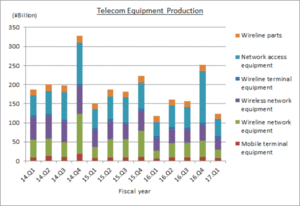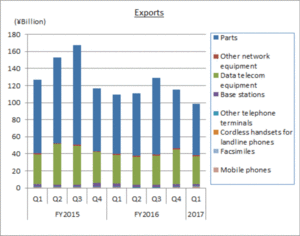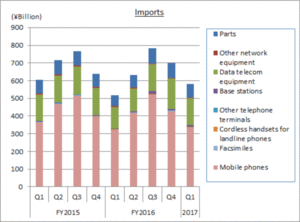The Communication and Information network Association of Japan (CIAJ) announces the telecommunication equipment and trade figures for April through June, 2017 as follows.
Japan’s GDP during April through June 2017 grew YoY (year-over-year) at an annual rate of 2.5% according to the preliminary figures announced this month by the Cabinet Office. This was the 6th consecutive quarter of positive growth. Consumer spending and housing investments remained healthy, but exports was sluggish, especially in electronic parts to China, and there seems to be a shift to economic growth led by domestic demand, rather than exports.
In the telecom equipment market, shift to overseas production continues, but domestic production is recovering, with the second consecutive quarterly growth from 2016 Q4. The adjustments in production by Chinese smartphone manufacturers resulted in shrinking demand for parts, leading to the 6th consecutive negative growth in exports. On the other hand, the recovery in domestic demand has translated into positive YoY growth for all import categories.
I. Domestic Production
(Based on Indices of Industrial Production compiled by the Ministry of Exonomics, Trade and Industry)
(1) FY2017 1st quarter actual
The total value of production was 122.9 billion yen, or positive 4.4% growth over the same quarter in FY2016. Recovery of the domestic economy led to strong figures for mobile phones and wireless network equipment.
(2) Trend by categories
Actual figures by categories were as follows:
- Wireline terminal equipment
13.5 billion yen (-18.2% over the same quarter of the previous year). Of which telephone sets was 700 million yen (-24.5% over the same quarter of the previous year) and key telephones 5.0 billion yen (-34.8% over the same quarter of the previous year), intercoms 7.5 billion yen (-1.1% over the same quarter of the previous year) and facsimiles 300 million yen (-7.5% over the same quarter of the previous year). The completion of the round of renewals of key telephones pushed the figure back to 2015 Q1 levels. - Mobile terminal equipment
43.9 billion yen (+21.8% over the same quarter of the previous year). Of which mobile phones was 35.3 billion yen (+34.0% over the same quarter of the previous year) and public-use PHS 400 million yen (+123.9% over the same quarter of the previous year). Demand for mobile phones made a huge come back – the first since the end to ¥0 (carrier subsidized) mobile phones in 2016 Q1. - Wireline network equipment
28.9 billion yen (-9.9% over the same quarter of the previous year). Of which central office switching systems was 1.1 billion yen (-56.4% over the same quarter of the previous year), PBX was 2.9 billion yen (-16.7% over the same quarter of the previous year) and digital transmission equipment was 9.8 billion yen (-11.3% over the same quarter of the previous year) and other transmission equipment was 14.1 billion yen (+2.1% over the same quarter of the previous year). Among switching equipment, the drop in central office switching systems due to PSTN migration, as well as continued declines in replacement demand for enterprise PBXs after the spike in 2015 contributed to the overall decline. Construction of hotels and offices should lead to new demand for key telephones and PBXs, but the trend for smaller systems will push the unit investments down and not contribute to a recovery. - Wireless network equipment
21.6 billion yen (+5.2% over the same quarter of the previous year). Of which fixed telecommunication devices was 5.6 billion yen (-23.7% over the same quarter of the previous year) and base station equipment was 16.0 billion yen (+21.2% over the same quarter of the previous year). Demand for base stations is increasing in order to accommodate rising traffic. - Network access equipment
8.2 billion yen (+38.5% over the same quarter of the previous year). Demand for network equipment was strong, reflected in the YoY growth figure, but the yen value was similar to that of 2015 Q1. - Wireline parts
6.8 billion yen (+2.4% over the same quarter of the previous year). Increased domestic production of mobile phones and healthy demand for parts of high-end smartphones by major U.S. and Korean brands contributed to the 3rd consecutive quarterly growth.
II. Exports
(Based on Indices of Industrial Production compiled by the Ministry of Exonomics, Trade and Industry)
(1) FY2017 1st quarter actual
The total figure for exports was 98.3 billion yen (-10.4% over the same quarter of the previous year), recording the 6th consecutive quarter of decrease starting in 2015 Q4. Exports of telephone sets and terminal equipment recorded positive year-over-year growth. In network equipment, domestic demand for base stations grew, while shrinking in exports. Data communications equipment recorded similar figures to previous Q1 numbers. Healthy demand for parts of high-end smartphones by major U.S. and Korean brands was not enough to offset decreased production and fierce competition in the in Chinese smart phone market, leading to an overall drop in exports.
(2) Trend by categories
Actual figures by category are as follows:
- Telephone sets and terminal equipment 2.2 billion yen (+64.2% over the same quarter of the previous year)
Of which, mobile phones was 1.4 billion yen (+147.7% over the same quarter of the previous year), facsimiles was 10 million yen (-82.5% over the same quarter of the previous year), cordless handsets for landline phones was 100 million yen (+54.7% over the same quarter of the previous year) and other was 700 million yen (+7.5% over the same quarter of the previous year). - Network equipment 36.1 billion yen (-6.8% over the same quarter of the previous year)
Of which, base stations was 2.1 billion yen (-45.4% over the same quarter of the previous year), data communication equipment was 32.6 billion yen (-3.1% over the same quarter of the previous year) and other network equipment was 1.5 billion yen (+9.0% over the same quarter of the previous year). - Parts (both wireline and wireless) 60.0 billion yen (-13.8% over the same quarter of the previous year)
(3) Actual figures by region
By region, Asia was 69.2 billion yen (-12.5% over the same quarter of the previous year), of which China was 32.1 billion yen (-33.9% over the same quarter of the previous year). North America was 15.6 billion yen (-2.5% over the same quarter of the previous year), of which the U.S. was 15.3 billion yen (-2.1% over the same quarter of the previous year). Europe was 9.8 billion yen (-2.9% over the same quarter of the previous year), of which the EU was 8.8 billion yen (-5.1% over the same quarter of the previous year). The export of parts to China decreased to 44.3% of total exports, dropping from 70.5% in 2015 and 63.1% in 2016 – all indicating adjustments in the production of smart phones in China and the shift in production to other Asian countries.
(4) Comparison and breakdown by regions
| First: | Asia 70.4% (-1.7% over the same quarter of the previous year) |
| Second: | North America 15.9% (+1.3% over the same quarter of the previous year) |
| Third: | Europe 10.0% (+0.8% over the same quarter of the previous year) |
| Other regions: | 3.7% (-0.4% over the same quarter of the previous year) |
III. Imports
(Based on Indices of Industrial Production compiled by the Ministry of Exonomics, Trade and Industry)
(1) FY2017 1st quarter actual
The total figure for exports was 582.7 billion yen (+12.9% over the same quarter of the previous year), recording the third consecutive positive quarterly growth from 2016 Q3. The higher domestic demand for mobile phones, which makes up 58% of total imports, contributed to the growth. Though small in yen value, the domestic demand for base stations recorded the 5th consecutive positive quarterly growth since 2016 Q1.
(2) Trend by categories
Actual figures by category are as follows:
- Telephone sets and terminal equipment 339.9 billion yen (+4.1% over the same quarter of the previous year)
Of which, mobile phones was 335.4 billion yen (+4.0% over the same quarter of the previous year), facsimiles was 1.4 billion yen (+30.5% over the same quarter of the previous year), cordless handsets for landline phones was 1.4 billion yen (+13.0% over the same quarter of the previous year) and other was 1.7 billion yen (+0.8% over the same quarter of the previous year). - Network equipment 164.5 billion yen (+27.4% over the same quarter of the previous year)
Of which, base stations was 8.8 billion yen (+100.6% over the same quarter of the previous year), data communication equipment was 150.6 billion yen (+24.6% over the same quarter of the previous year) and other network equipment was 5.1 billion yen (+31.6% over the same quarter of the previous year). - Parts (both wireline and wireless) 78.3 billion yen (+29.2% over the same quarter of the previous year)
(3) Actual figures by region
By region, Asia was 547.4 billion yen (+13.5% over the same quarter of the previous year), of which China was 406.4 billion yen (+1.0% over the same quarter of the previous year). North America was 18.1 billion yen (+5.4% over the same quarter of the previous year), of which the U.S. accounted for 17.7 billion yen (+6.7% over the same quarter of the previous year). Europe was 8.5 billion yen (+8.6% over the same quarter of the previous year), of which the EU was 8.2 billion yen (+7.0% over the same quarter of the previous year).
(4) Comparison and breakdown by regions
| First: | Asia 93.9% (+0.4% over the same quarter of the previous year) |
| Second: | North America 3.1% (-0.2% over the same quarter of the previous year) |
| Third: | Europe 1.5% (0.0% over the same quarter of the previous year) |
| Other regions: | 1.5% (-0.2% over the same quarter of the previous year) |
IV. Trends in Orders Received and Shipped
(from CIAJ statistics)
CIAJ statistics for total orders received and shipped amounted to 406.8 billion yen (+1.2% over the same quarter of the previous year) for the quarter. Telephone sets, telephone application equipment, multi-functioning facsimiles, mobile phones/smart phones, optical transmission equipment and telecom equipment parts recoded positive growth over the same quarter of the previous year.
The total value of domestic shipments totaled 316.6 billion yen (+1.9% over the same quarter of the previous year) and exports was 90.2 billion yen (-1.1% over the same quarter of the previous year).
For details, contact
Market Research
CIAJ
tel: 81-3-5403-9356 fax: 81-3-5403-9360
For more general inquiries, contact
Corporate Communications
CIAJ
tel: 81-3-5403-9351 fax: 81-3-5403-9360



